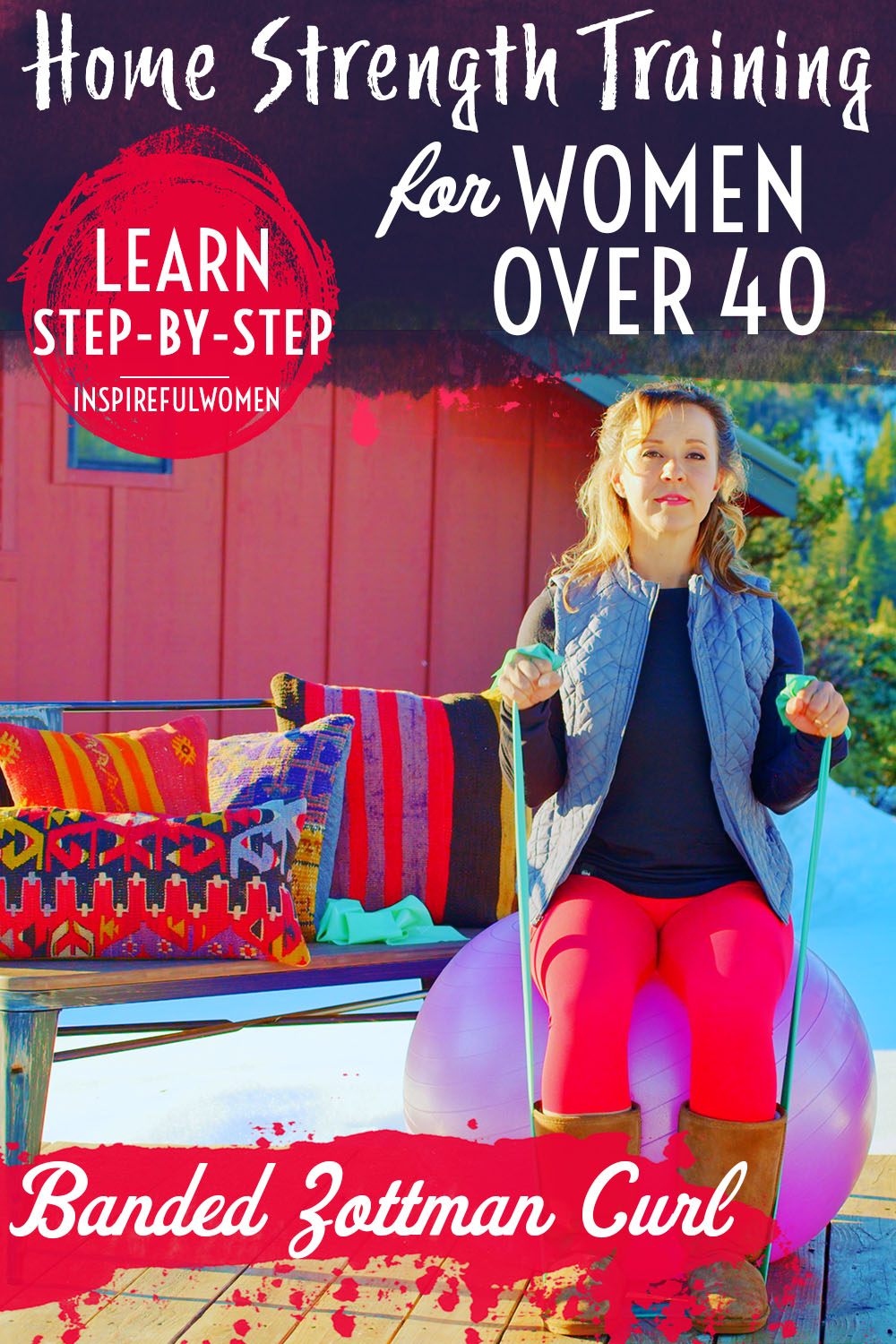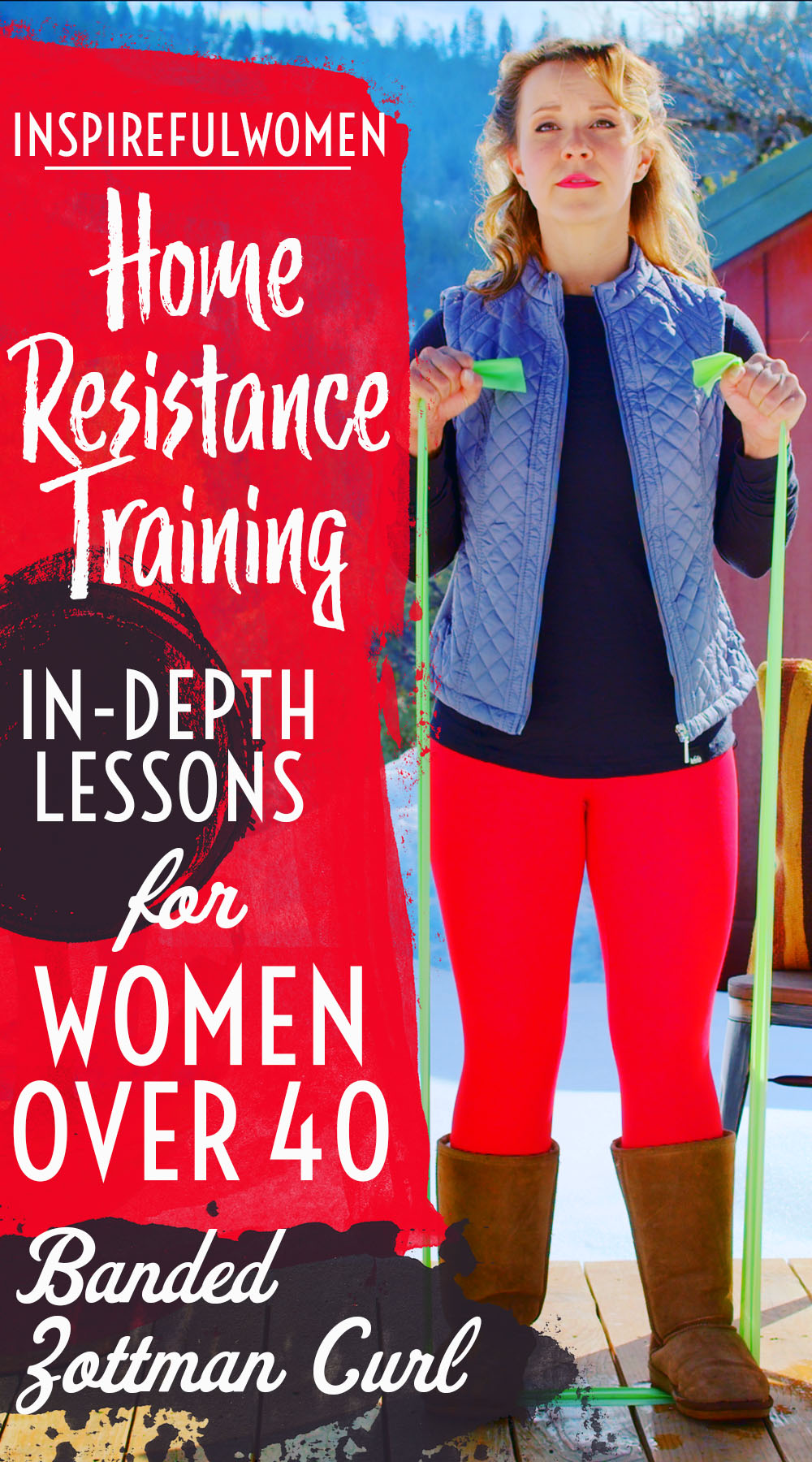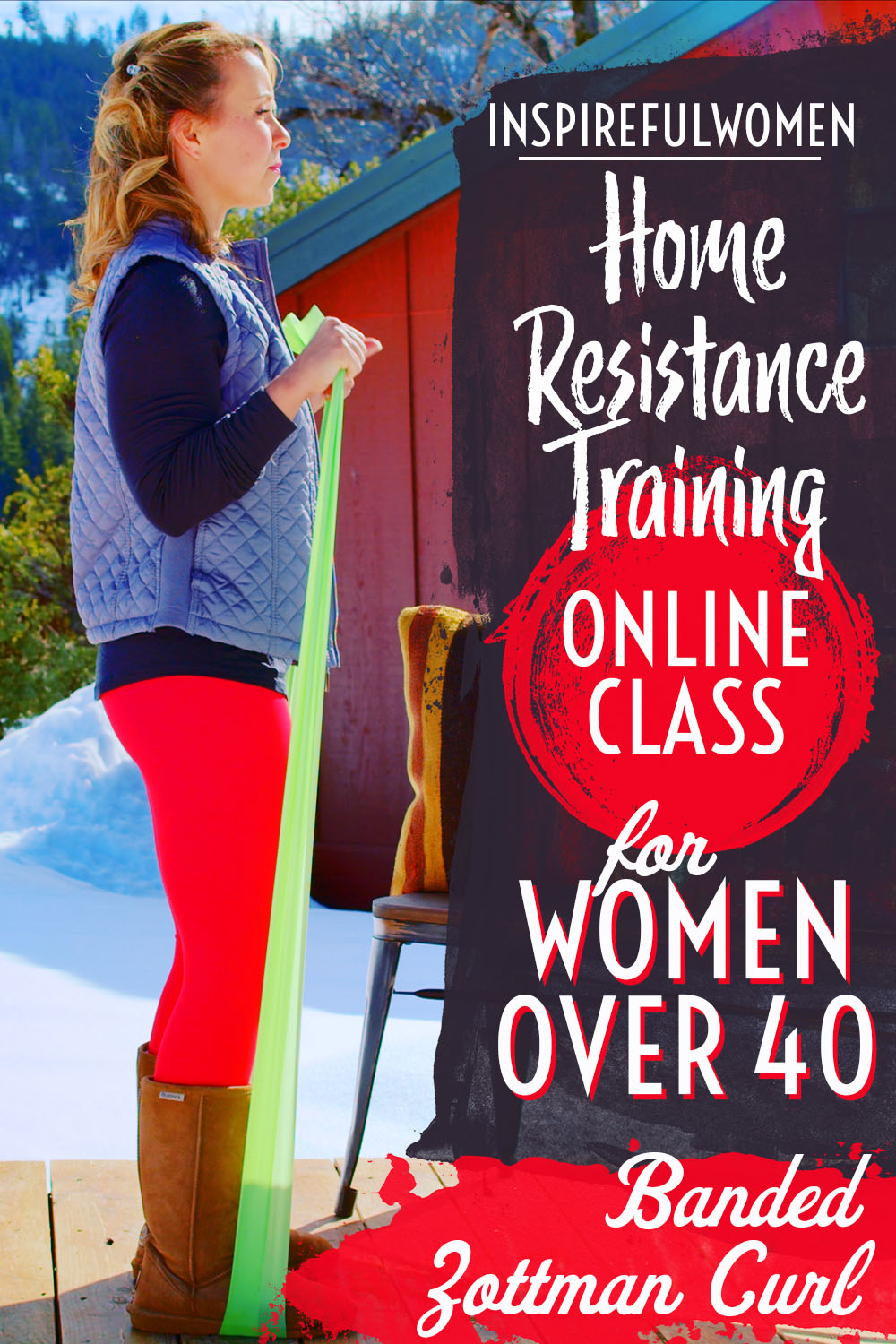Band Zottman Curl
How to Do Standing Band Zottman Bicep Curls Alternative | In-Depth Guide [VISUAL LEARNERS]
Proper Form, Common Mistakes, & Variations + Easier | Home Resistance Training
WHAT DO YOU WANT TO SEE?
QUICK DEMO
QUICK DEMO
MUSCLES THIS WORKS
MUSCLES
MAIN MUSCLES WORKED IN Band Zottman Bicep Curls
biceps brachii, brachialis, & brachioradialis
STARTING POINTERS
Starting Pointers
WHAT WE'RE DOING TODAY
ALL WE'RE DOING:
A bicep curl variation, except when you lower the resistance band each rep your palms will be facing down rather than up.
This variation of the Zottman Curl is easy and convenient because you can do it almost anywhere. The use of a resistance band will result in increased resistance as the elbow bends.
This will work the biceps muscle most near its end range where the muscle is not able to produce as much force. This is cool because it's just a different way to work the muscle. The brachialis is strongest at approximately 100 degrees of elbow flexion (bend), so the band is a bit more effective for targeting that muscle than the dumbbell is, especially since the brachialis will be working mostly in the eccentric phase.
HOW TO DO THE EXERCISE
LOOKS
HOW Band Zottman Bicep CurlS SHAPE OUR BODY
Builds size and tones muscles of the upper arm and forearm.
PROPER FORM
PROPER FORM: Band Zottman Bicep Curls
EQUIPMENT, SETS & REPS
EQUIPMENT
Main set (3: Light/Med/Heavy)
X-Heavy Band (I recommend getting this too if you plan to use resistance bands frequently).
SUGGESTED STARTING WEIGHT FOR WOMEN:
Moderate strength resistance band.
One band under both feet, hold one end in each hand; or, two bands - one under one foot, one under the other foot.
SETS & REPS:
2 sets of 8 – must fatigue the muscle
PACE:
Quicker (0.5 sec) up movement (concentric) – increased power will increase the involvement of the brachioradialis. And slow eccentric (lowering) 3-5 seconds.
WAYS TO ADJUST RESISTANCE FOR BANDS:
One or a combination of these ideas:
Double up 2 resistance bands to increase the amount of resistance.
Hold both ends of the resistance band to double the amount of resistance.
Shorten the band.
Easier to hold
Knot or tie a loop in the ends of the band to make it easier to grip.
Loop the band across the palm, not at the fingers.
Lightest loop band or therapy loop band is easiest to grasp.
BODY POSITION
BODY POSITION FOR THE Band Zottman Curl
BAND: Place band under both feet, hold one end in each hand.
FEET: Shoulder-width apart, toes forward
BODY STANCE: Neutral spine position, knees slightly bent, sternum lifted, shoulder blades in and down the back.
ARM: Down by your sides. Elbows straight. Upper arm resting by the body but not squeezed in. This will allow free movement at the elbow joint and facilitate biceps activation because it will have to support the upper arm as opposed to locking it on the body. It also increases core muscle activity because you are not bracing your trunk and arm together).
HAND/GRIP: Palms facing forward (forearm supination) – soft side of forearm forward (when arms are down at sides). The band should be held so that it runs from the pinky side of the palm to the thumb side of the hand. The band comes up from under the foot, over the pinky side of the palm (when the palm is facing up), across the palm, and is anchored in the space between the thumb and the forefinger. It is ok to wrap the band around the palm of the hand once or twice if that is more comfortable. Band taut in starting position.
NECK: Neutral and relaxed.
HOW TO DO
HOW TO DO Band Zottman Bicep Curls
CUE: All movement is isolated to the elbow joint and forearm (rotation).
Bend your elbows to pull the hand up towards your shoulder.
Once you have reached the end of your elbow flexion (fully bent), pause, then rotate the palm to face forward/down (forearm pronation) and slowly lower the weights back down to the starting position.
When your elbow is nearly straight, supinate (turn the palm forward) the forearm and begin the next rep.
HOW TO SAFELY GET OUT OF THE EXERCISE
Straighten your elbows, release the band.
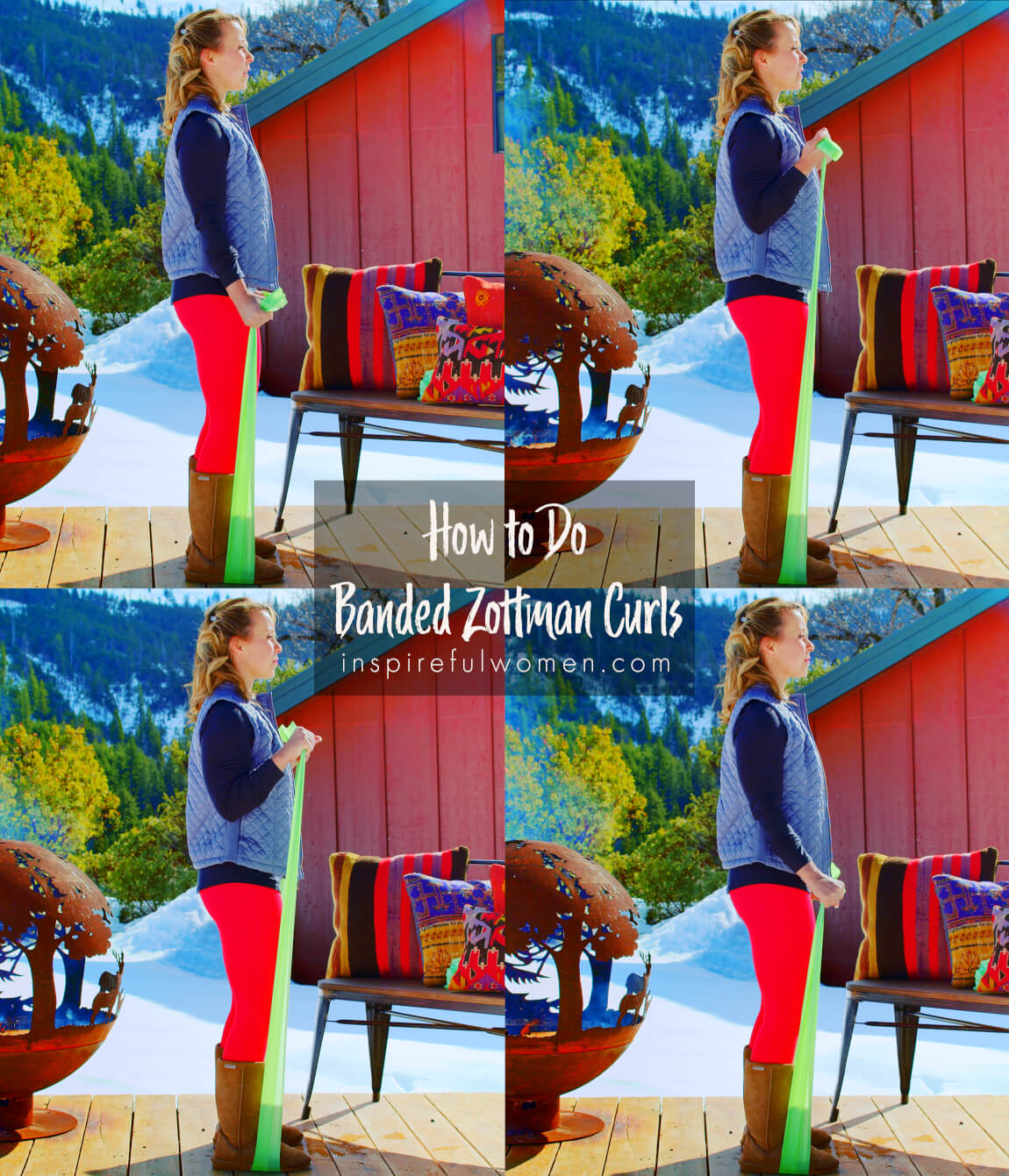
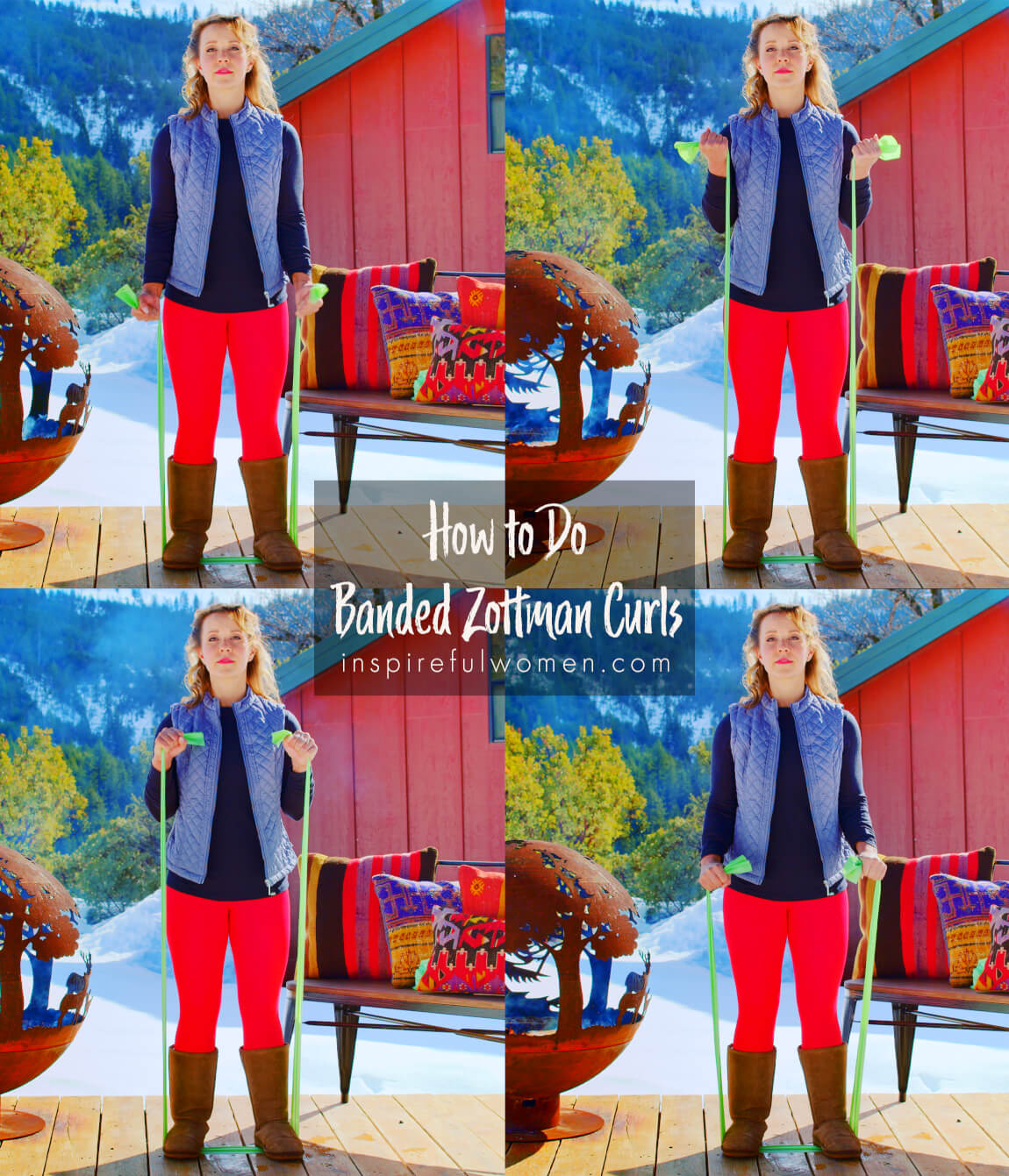
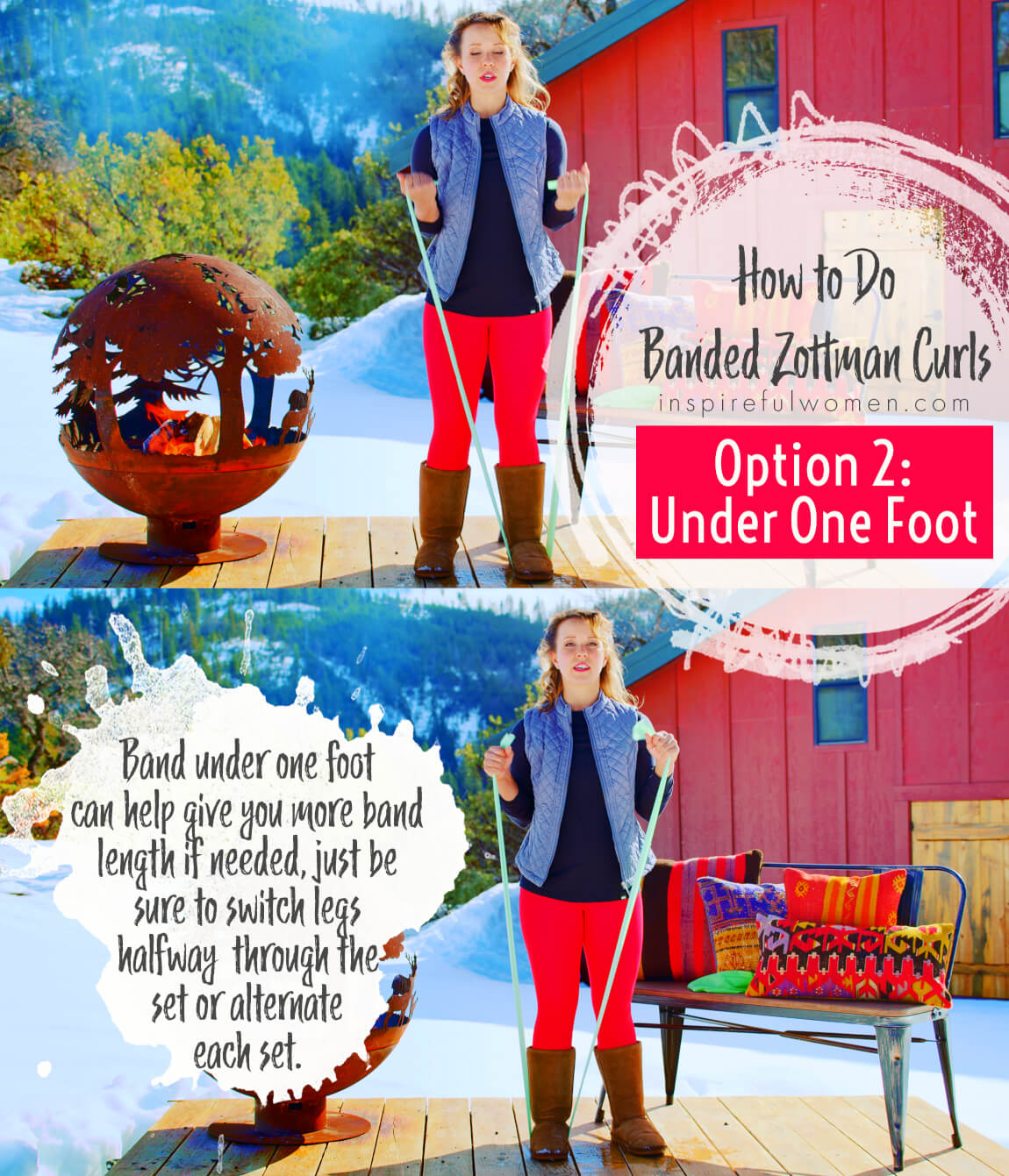
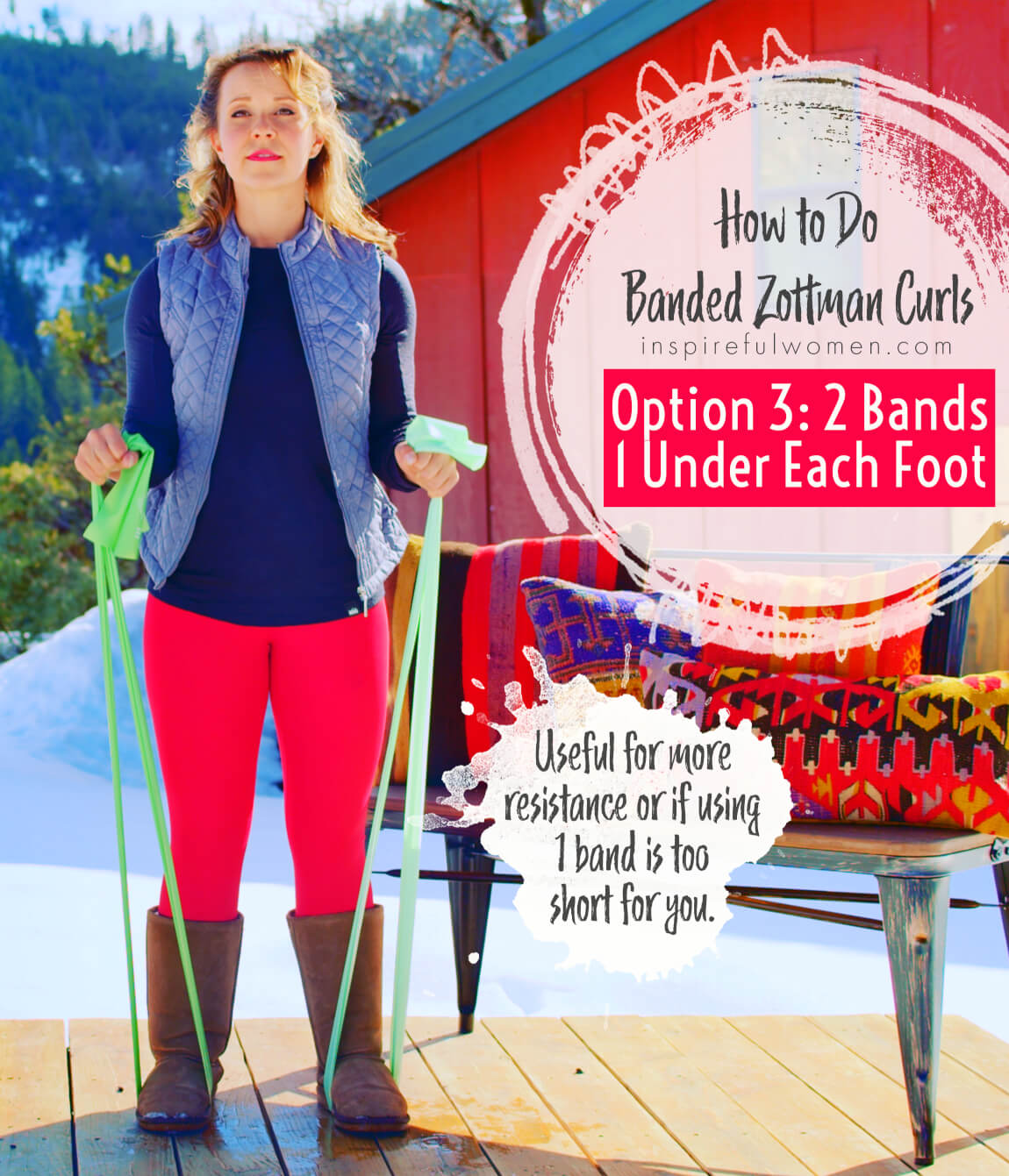
COMMON MISTAKES
COMMON MISTAKES
WHAT TO AVOID WITH THE Band Zottman Bicep Curl
KEY TIP:
Guess what? Good news! Many avoids are the same for most movements. Once you learn the basics, there's really only a few extra avoids for each individual movement.
1. Avoid moving through the wrists
AVOID: Avoid bending at the wrists.
WHY NOT?
- Poor alignment (bent forward or backward) or repetitive movement through the wrist can lead to joint and/or soft tissue irritation or injury over time.
WHAT TO DO:
- Your wrists should be in line with your forearm and should be still throughout the exercise.

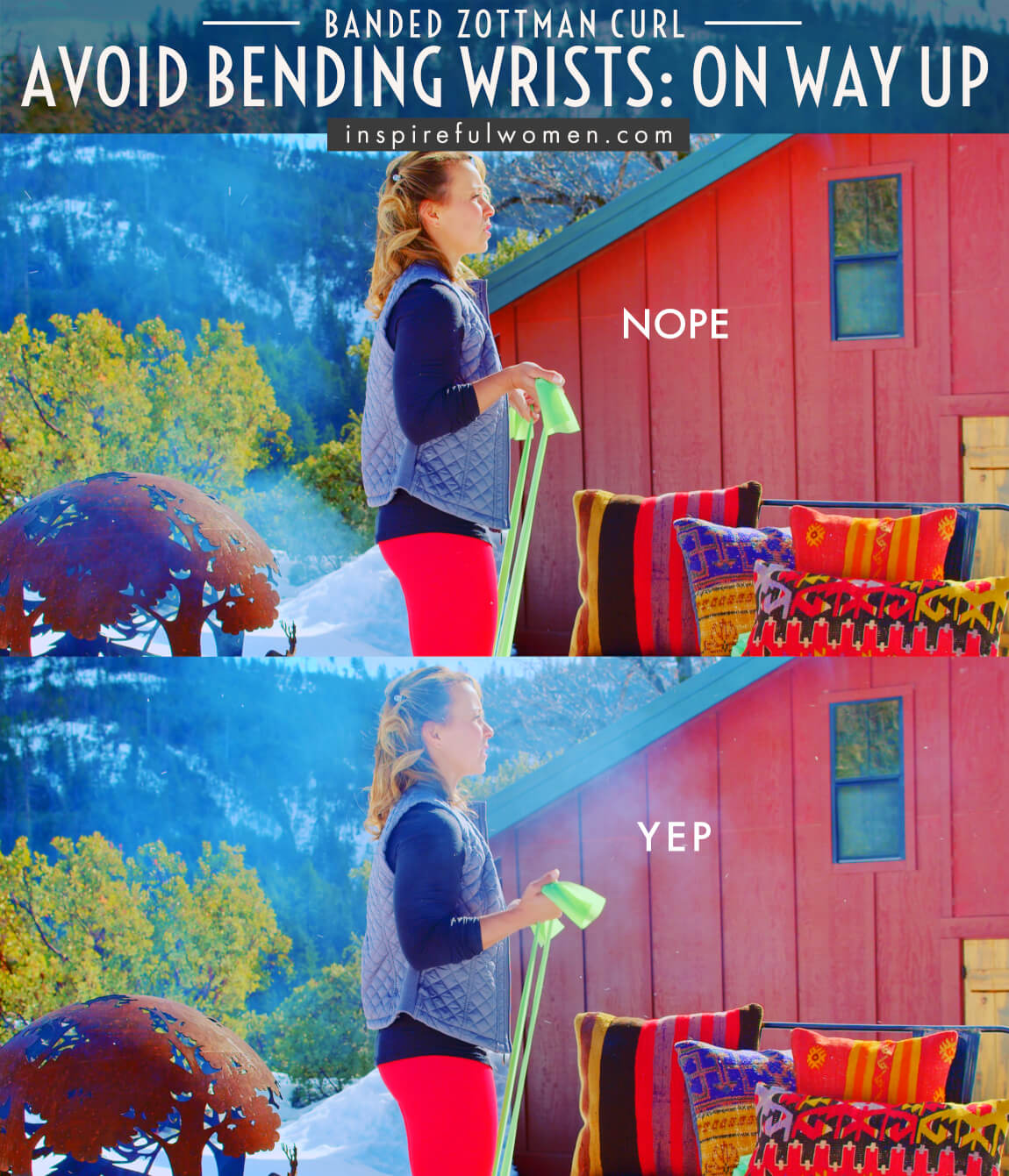
2. Avoid Arching Your Low Back
AVOID: Avoid extending low back
WHY NOT?
- This compresses the joints of this area of the spine and can irrirate the tissues or cause muscle strain.
WHAT TO DO:
- Maintain a neutral spine position - keep your abs engaged gently to help keep the spine from arching back.
- Avoid locking the knees - this can cause you to arch your low back.
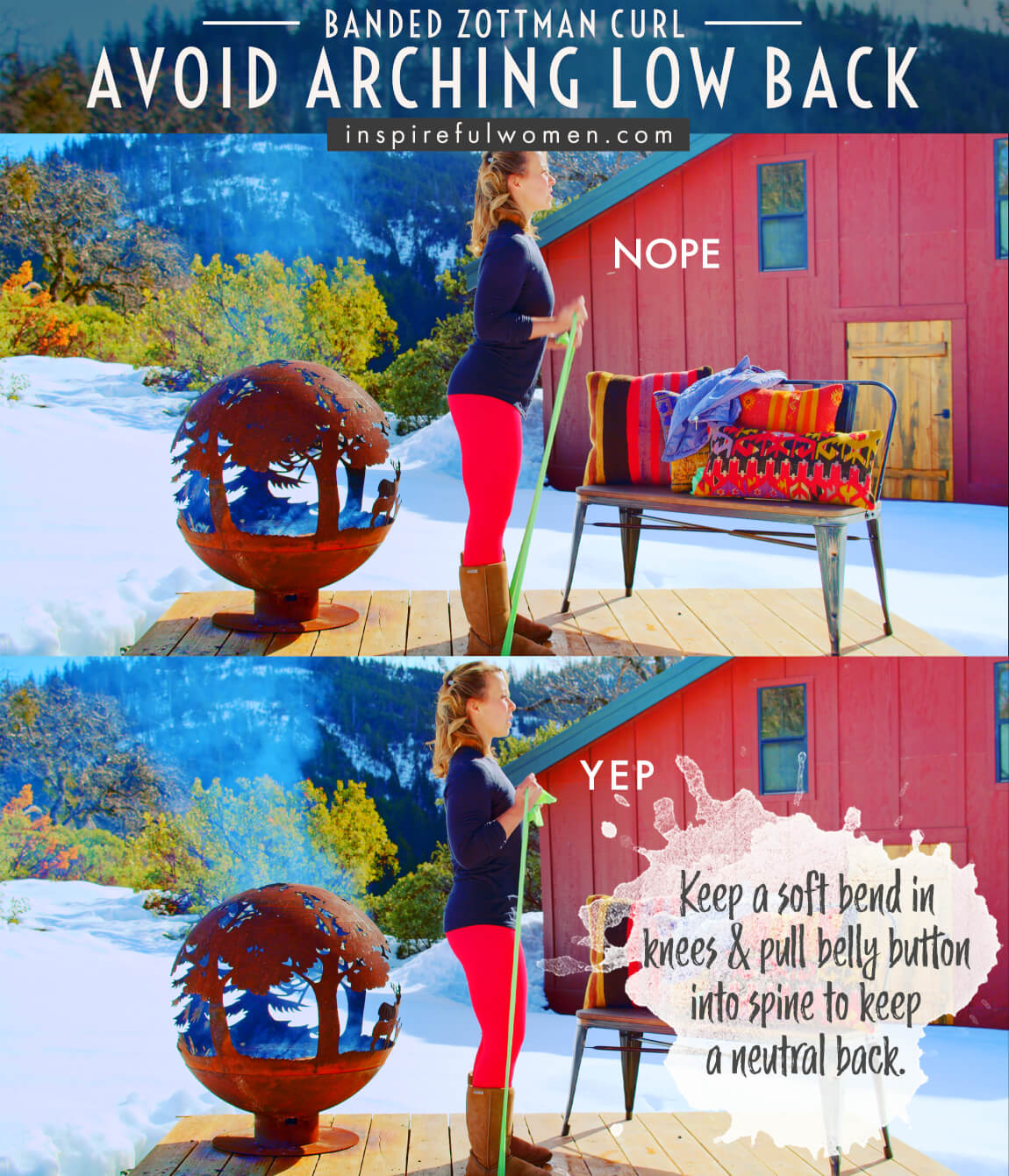
3. Avoid Locking Knees
AVOID: Avoid straightening or locking the knees of standing legs.
WHY NOT?
- This tends to change the lumbar curve, pull on the hamstrings and decrease the muscle activity of the legs.
- Locking the knees puts stress on the knee joint and can make it more difficult to maintain a neutral spine. The knees should be soft.
WHAT TO DO:
- Keep a soft bend in the knees.
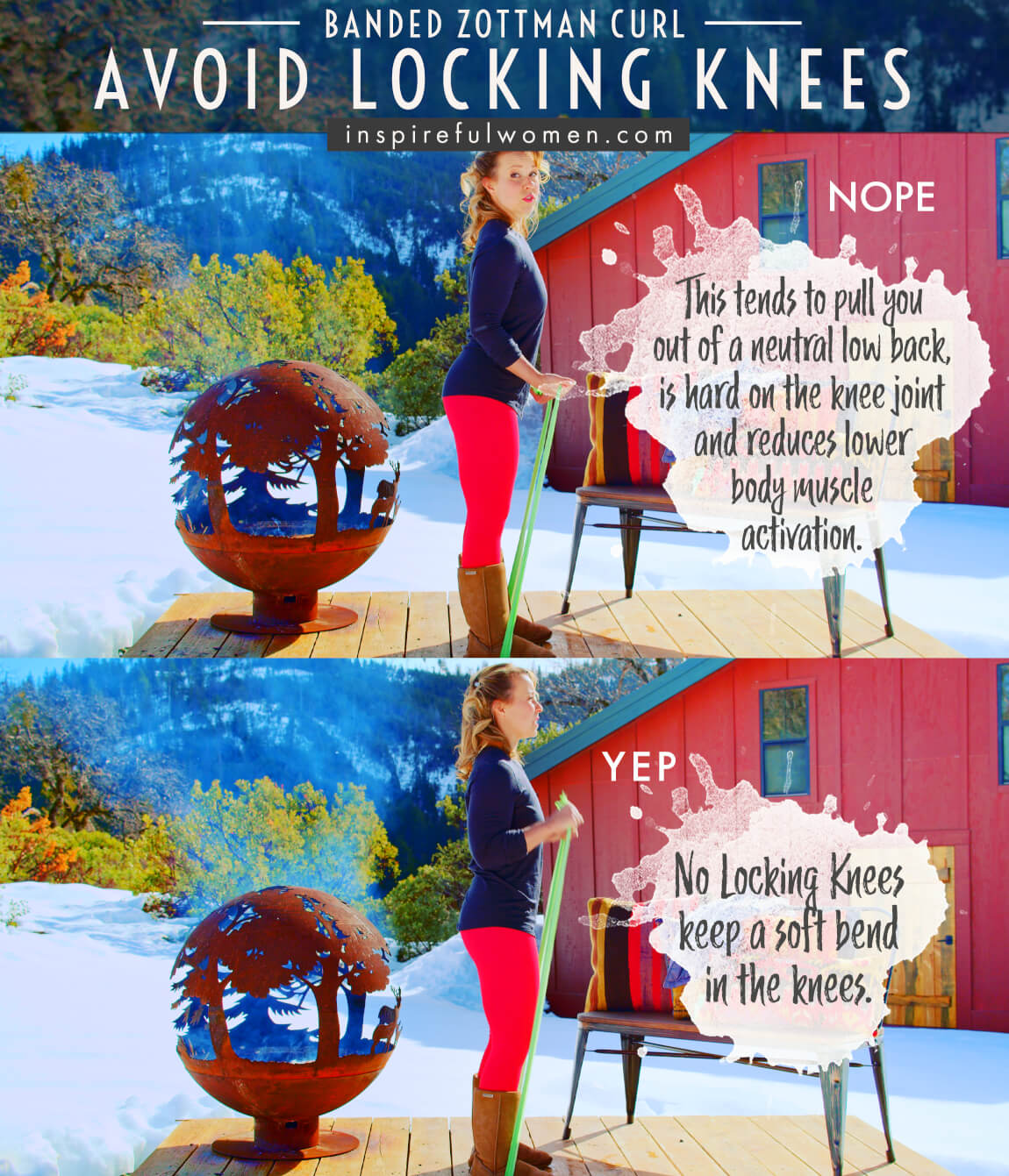
4. Avoid Rounding Upper Back
AVOID: Avoid rounding your upper back or shoulders.
WHY NOT?
- This can lead to neck, shoulder injury, or damage over time and can result in using the wrong muscles (upper trap).
WHAT TO DO:
- Pull your shoulders blades back, and in towards each other, thinking about having a broad chest - this will help you keep a healthy position with the shoulders.
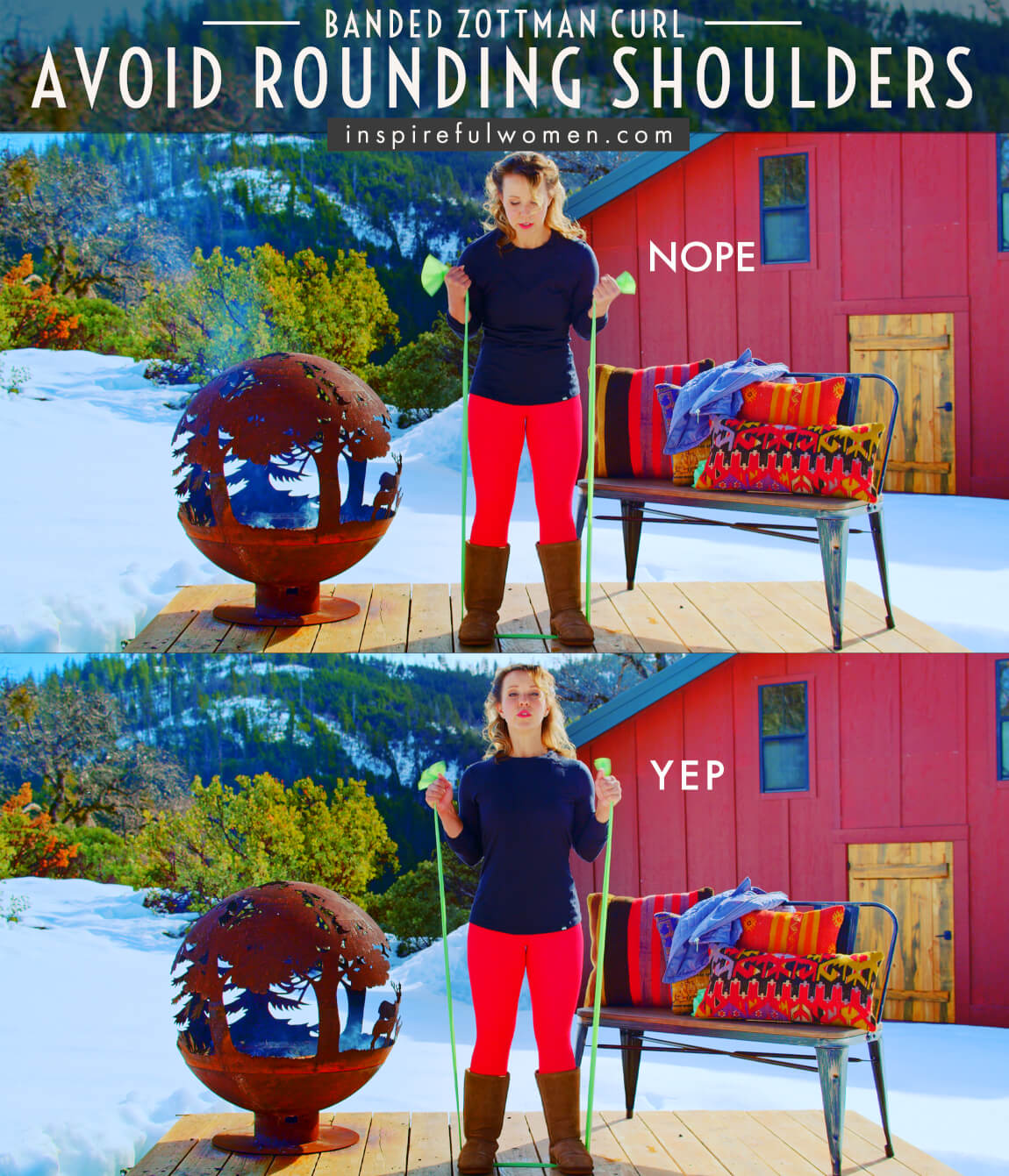

5. Avoid Elbows Flaring Out
AVOID: Avoid letting your elbows move out to the sides.
WHY NOT?
- This will change the downward pull of gravity and will increase the activity of the shoulder.
WHAT TO DO:
- The upper arm should be resting at your sides, not moving.
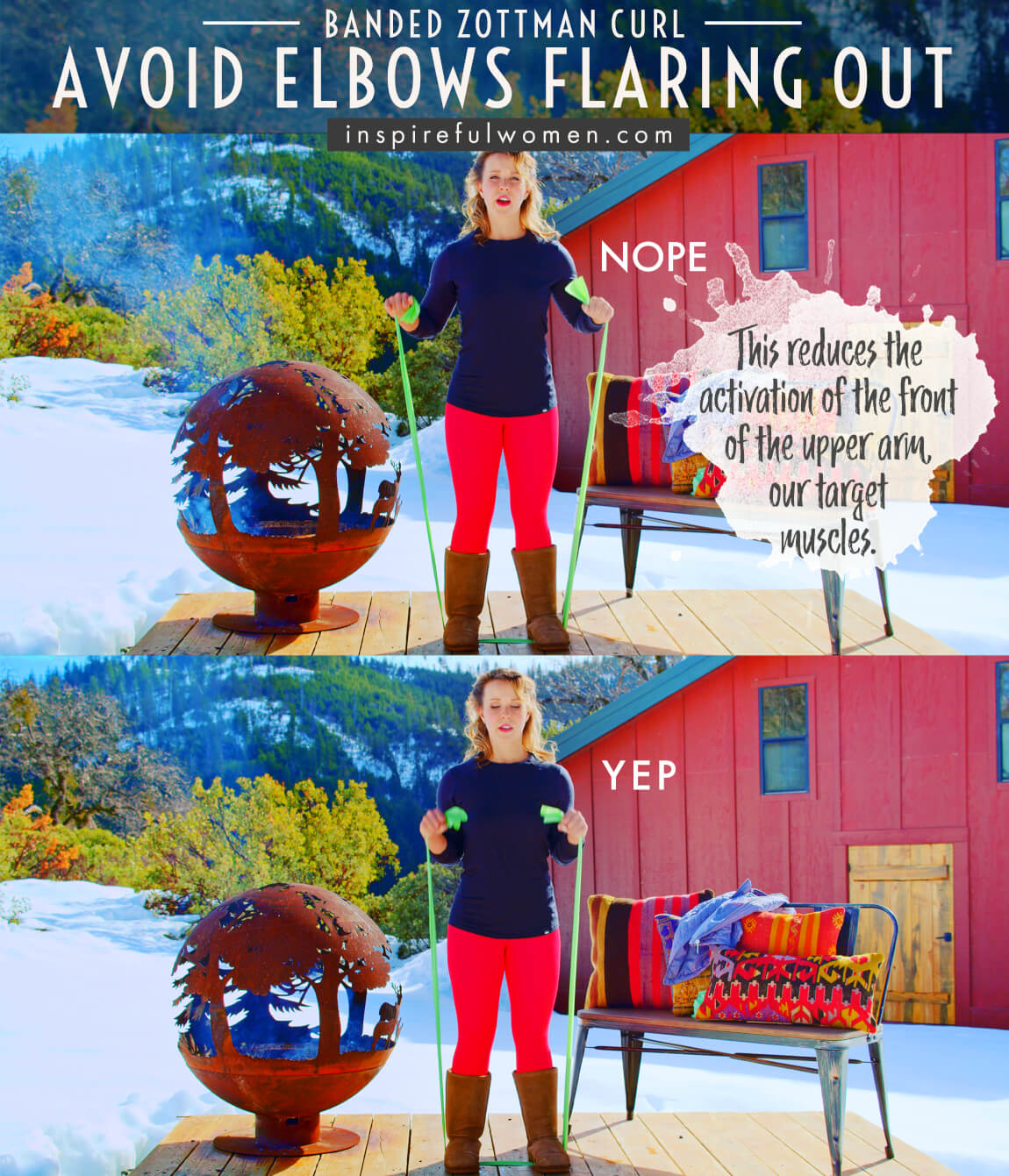
VARIATIONS
VARIATIONS
VARIATIONS OF the Band Zottman Curl
Single Arm
One Arm Zottman Bicep Curl
This will change the core muscle activation – the core will not have to stabilize against the weight of two dumbbells, but the core muscles will have to stabilize against a pull to one side – so more of the lateral muscles (obliques and quadratus lumborum). This can be done by doing one set on one side.

ALTERNATING
Alternate Band Zottman Curl
Alternating arms is a good choice if you are lifting heavy weights and your arm needs a short break between reps. It will work the core a bit differently - the core muscle activation will need to switch side to side with each rep (so more coordination needed). Avoid rocking the body side to side.

MAKE IT EASIER
EASIER
MAKE THE Band ZOTTMAN CURL MORE DOABLE
Stability Ball
Band Zottman Curl on Stability Ball
Seated on ball decreases the core activation - so less than standing but more than sitting on bench or chair.
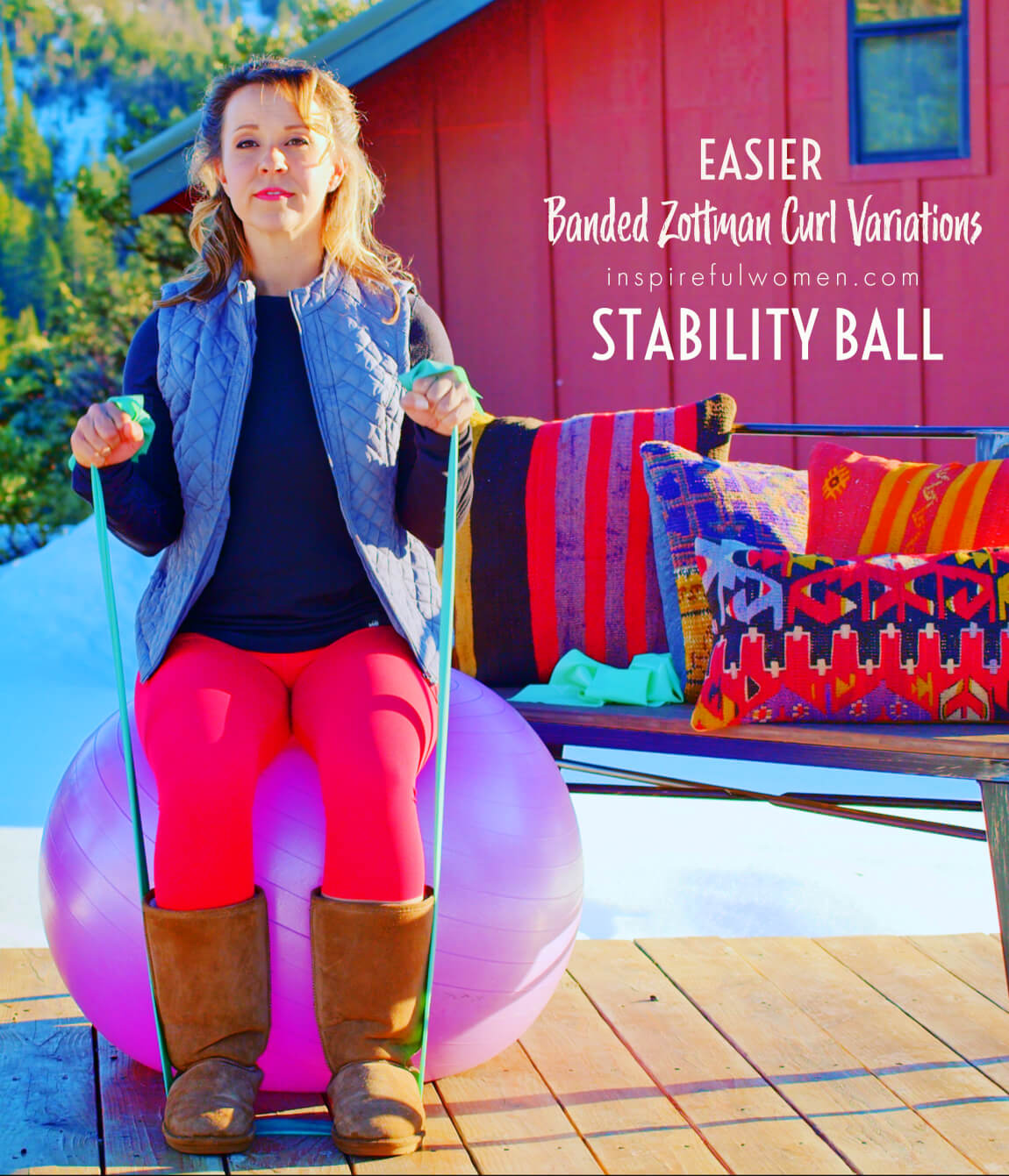
Seated
Seated Band Zottman Curl
Seated so the focus can be on the lower arm movement. Less attention is needed to stabilize the torso.
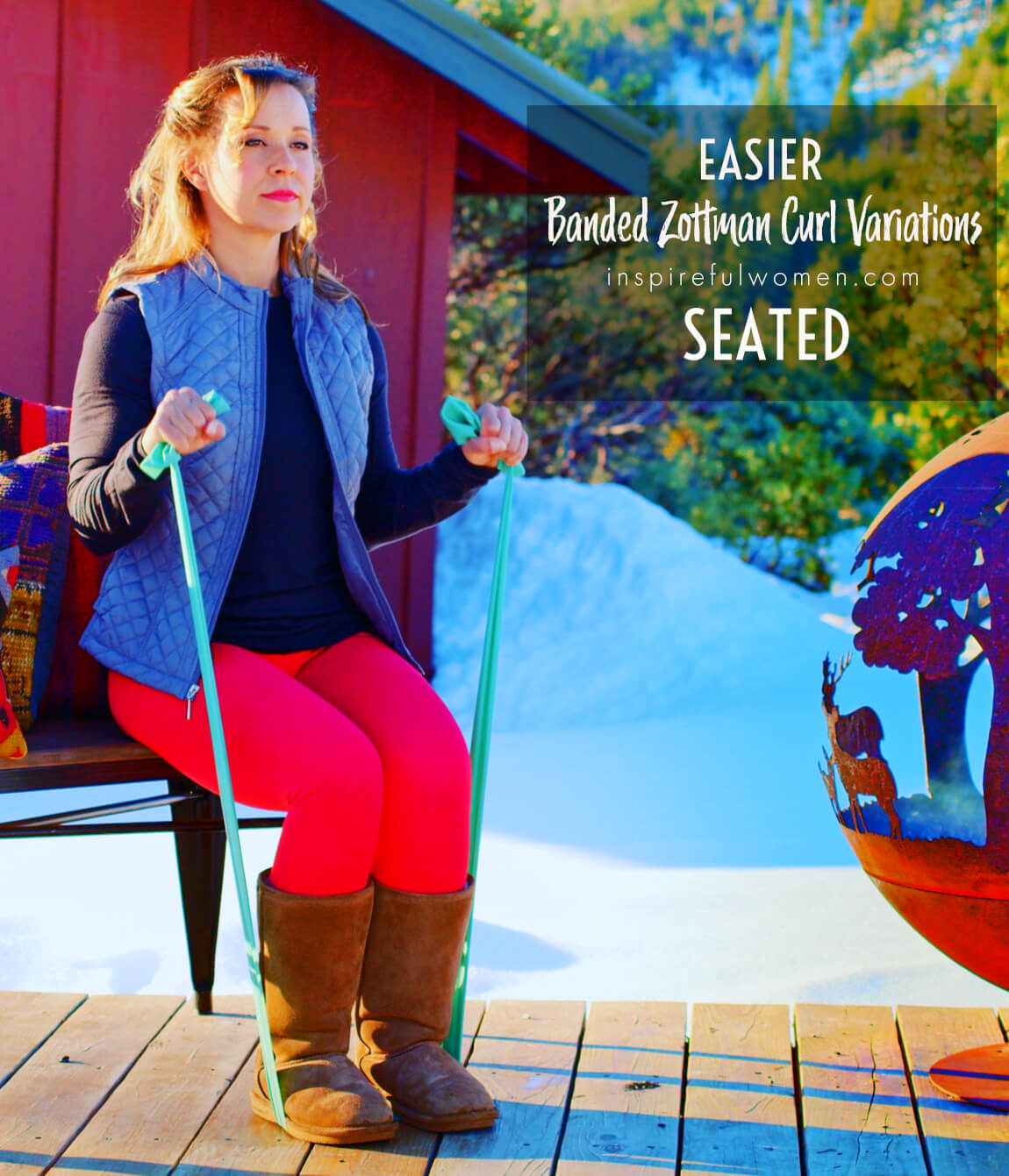
WHAT WE'RE DOING TODAY
WHAT & WHY
BENEFITS OF TRAINING THE biceps brachii, brachialis, & brachioradialis
WHAT
WHAt's this all about anyway?
Strengthen OTHER Muscles At the Front of Our Arms ASIDE from our Biceps
The Zottman curl exercise will strengthen our biceps too, no doubt about that, but did you know we actually have other muscles in the vicinity of our arm where the biceps muscle is too?
One of them is called the brachialis. This is a smaller muscle that lies beneath the biceps muscle. But it's important too! And it also bends the elbow.
The brachialis muscle is able to "shine" more and be more a part of what we're trying to do when we bend our elbows with our palms facing down or facing each other - things like pulling a chair out from the table, or trying to pull that stinkin' freshly watched fitted sheet over the bed. Or holding a camera for a long time because you just don't want to miss any memories of that family beach gathering.
Because the biceps brachii is the strongest of the muscles that bend the elbow, in order to work the deeper, smaller brachialis muscle more effectively without the biceps taking over, we adjust our forearm position - when we turn our palms downward, this puts the biceps muscle in a stretched position that limits its ability to do the work.
WHY BOTHER DOING IT?
WHY
WHY DO WE EVEN CARE?
Ever Wish You Could Pull Yourself Up Better? Or Just Open Those Darn Vacuum-Seal Tupperware?
Training these muscles can really improve your pulling strength, especially when your palms are facing down - things like when hiking, pulling yourself up a larger rock/boulder, or when I try to get the lid of my vacuum seal glassware ;).
The reason to work the brachialis is because it is able to contribute in positions where the biceps muscle is not as strong. So for instance, typically, you can carry or lift more when your palms are up, but we also need to be able to lift and carry things with our palms in other positions right?
When the forearm is pronated (this is when your palms are facing down) the bicep is weaker but the brachialis is just as strong, regardless of what position the forearm is in.
These elbow flexor exercises involve positioning the forearm in varying degrees of pronation, neutral, and supination in order to target the different muscles.
Aside from that, I mean ZOTTMAN - it's just a cool name, right? So therefore we should do this exercise.
EVERYDAY LIFE
EVERYDAY LIFE &
MUSCLE FUNCTION
HOW WE USE OUR bICEPS MUSCLES IN EVERYDAY LIFE
1. BENDING THE ELBOW
- Bringing your morning cuppa joe to your lips (I have cuppa black tea - doesn’t sound nearly as romantic)
- Lifting objects where you bend the elbows
- Weeding
- Pulling a door open
- Eating
- Moving furniture with desks & tables with palms underneath the top of the surface
- Hammering
2. ROTATING THE FOREARM SO THE PALM IS UP, ESPECIALLY WITH BENT ARM - SUPINATION (BICEPS BRACHII ONLY):
- Turning a doorknob
- Using a screwdriver
- Picking up your iPhone to look at it
- Knitting/Crocheting - repeatedly turning the palms down & back up
- Turning a can opener
- Hand-quilting
3. ROTATING (PRONATION TO SUPINATION) WHILE BENDING (FLEXING) AND STRAIGHTENING (EXTENDING) THE ELBOW
- Picking items up and putting them in your mouth - like picking and eating raspberries
- Brushing hair
- Treading water
- Playing tennis, golf
4. THE BICEPS BRACHII ALSO FLEXES (MOVES UP IN FRONT OF THE BODY) THE UPPER ARM - BUT THAT FUNCTION IS NOT TARGETED WITH THIS EXERCISE
HOW TO FEEL WHAT MUSCLE IS WORKING
How to Feel What Muscle is Working
Holding a dumbbell, bend the elbow to 90 degrees. You can feel the bulk of the muscles on the upper arm, and the biceps tendon as it crosses the eye of the elbow (where they insert the needle for blood draws) and insert on the forearm.
Rotate the forearm palm up and palm down, you will feel the muscles in the forearm (close to the elbow joint) working. Holding the arm still and placing your non-working arm around the forearm, move the wrist in all directions - you will feel all of the muscles in the forearm working to move the wrist - these are the same muscles that stabilize the wrist so that it does not move during the elbow flexion exercises.
SCIENCY STUFF
SCIENCY STUFF
SPIFFILICIOUS FACTS ABOUT MUSCLES & MOVES
About these muscles: The elbow is formed by three bones (the upper arm bone and two bones in the forearm) and three joints. THE ELBOW JOINT IS LARGELY A HINGE JOINT, where the two bones (ulna and radius) of the forearm form joints with the upper arm bone. The three main muscles that act to bend (flex) the elbow are the biceps brachii, brachialis and brachioradialis. The biceps brachii has two heads that originate on the shoulder blade. The brachialis and brachioradialis muscles originate on the lower part of the upper arm bone (humerus). All three muscles cross the elbow to insert on the bones of the forearm. The biceps brachii and brachialis muscles make up the bulk of the front of the upper arm and when they contract, you can picture the lower arm (the forearm and hand) getting pulled up toward your body as the two muscles pull on the forearm bones they’re attached to.
The biceps brachii flexes the forearm (bends the elbow), supinates the forearm (turns the forearm so the palm is up), flexes the arm (lifts the arm to the front of the body). When the forearm is pronated (palm down), the biceps brachii becomes less capable of flexing the forearm. Attached to radius forearm bone. [does have an attachment to the ulna by the aponeurosis to the fascia].
The brachialis muscle flexes the forearm regardless of whether the forearm is pronated or supinated. When the forearm is pronated the brachialis is more capable of flexing the forearm than the biceps is. The brachialis is attached to MUCH of the upper arm bone, the humerus - about 2/3rds in fact! It’s the prime elbow flexor when the forearm is pronated. Attached to ulna forearm bone.
The brachioradialis is another elbow flexor - the belly of the muscle lies on the forearm-it originates on the bottom of the upper arm bone and attaches to the end of the radius (one of the bones in the forearm). It is most active when the forearm is between pronation or supination, as in hammering. The brachioradialis will contribute to elbow flexion in all forearm positions - the amount of contribution increases when the weight is heavy or the movement is fast (contributes when the biceps and brachialis need help). In the Zottman the brachioradialis will contribute most during the eccentric phase of the movement, when the forearm is pronated. https://www.ncbi.nlm.nih.gov/pmc/articles/PMC4526813/
Because the biceps brachii is the strongest of the muscles that bend the elbow, in order to work the deeper, smaller brachialis muscle more effectively without the biceps taking over, we adjust our forearm position - when we turn our palms downward, this puts the biceps muscle in a stretched position that limits its ability to do the work.
The bones of the forearm - the ulna and radius form a joint that rotates one bone across the other bone. The result is the ability to turn your hand over, from a palm up to a palm down position. When the forearm rotates, it changes the way the muscle works. Knowing this, it is possible to exercise the elbow flexors in a variety of different positions of the forearm to target specific muscles.
ALLLL MUSCLES & WHEN
ALL MUSCLES WORKING & WHEN DURING THE Band Zottman Bicep Curl
The shoulder and core stabilizers work throughout the movement to hold the spine in a neutral position, hold the shoulder blade down and back (depression and retraction), and to hold the upper arm still.
To begin the biceps and supinator muscles rotate the forearm into supination (palm forward). The biceps, brachialis work to bend the elbow. The brachioradialis does not contribute unless power or speed is needed – for quicker movements or heavy loads, and in the supinated position, its contribution is minimal. The wrist flexors (flexor carpi radialis and ulnaris, palmaris longus) hold the wrist in a neutral position as the band pulls down on the hand.
At the top of the movement, the pronator teres and quadratus rotate the forearm so that the palm faces to the front. There is very little resistance on the muscles in this position, so their effort is small.
The brachialis (biceps brachii may contribute but it is minimal) works eccentrically to straighten the elbow and return to the starting position.
The wrist extensors (extensor carpi radialis longus and brevis, extensor carpi ulnaris) work to hold the wrist in a neutral position as the band pulls down on the hand.
PIN IT FOR LATER!
